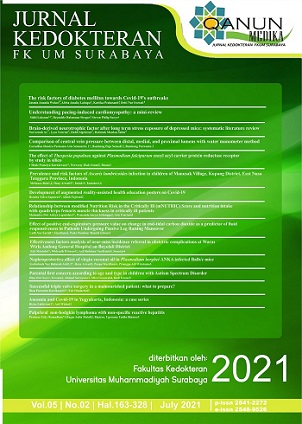Relationship between modified Nutrition Risk in the Critically Ill (mNUTRIC) Score and nutrition intake with quadriceps femoris muscle thickness in critically ill patients
Abstract
Abstract
Â
Muscle wasting in critical illness is seen from inadequate nutrition intake and stress catabolism. Modified Nutrition Risk in the Critically Ill (NUTRIC) Score is a screening tool that measures starvation, inflammation, disease severity, and organ dysfunction. Relationship between muscle strength and muscle thickness causes the evaluation of muscle thickness is quite relevant. This study aimed to analyze the relationship between modified NUTRIC score and nutrition with muscle wasting in critically ill patients. The study was conducted on 30 patients in the ICU Dr Soetomo Hospital Surabaya. Nutritional intake and thickness of the quadriceps femoris muscle were monitored for one week. There was a relationship between mNUTRIC score with quadriceps femoris muscle thickness on days 3rd, 5th, and 7th. In the comparison between the low risk group and the high-risk group, it was found that there was a significant difference in the change in the percentage of muscle thickness difference on the 3rd, 5th and 7th day observation. There is a relationship between protein debt with quadriceps femoris muscle thickness (p = 0.008) with a positive correlation with moderate correlation strength (r = 0.477) on day 7. In conclusion, the modified NUTRIC Score had a moderate relationship with quadriceps femoris muscle thickness in critical patients from day 3rd until day 7th. The calorie intake not had a relationship with quadriceps femoris muscle thickness. Protein intake had a moderate relationship with quadriceps femoris muscle thickness only on day 7th measurement in critical patients.
Â
Keywords            : Modified NUTRIC Score, Nutrition, Quadriceps Femoris muscle
Correspondence  :          mdr.lopulalan@gmail.com
Full text article
References
Berg, H. E. et al. (2007) ‘Hip, thigh and calf muscle atrophy and bone loss after 5-week bedrest inactivity’, European Journal of Applied Physiology, 99(3), pp. 283–289.
Casaer, M. P. and Ziegler, T. R. (2015) ‘Nutritional support in critical illness and recovery’, The Lancet Diabetes and Endocrinology, 3(9), pp. 734–745.
Ferrie, S. et al. (2016) ‘Protein Requirements in the Critically Ill: A Randomized Controlled Trial Using Parenteral Nutrition’, Journal of Parenteral and Enteral Nutrition, 40(6), pp. 795–805.
Fetterplace, K. et al. (2018) ‘Targeted Full Energy and Protein Delivery in Critically Ill Patients A Pilot Randomized Controlled Trial (FEED Trial)’, Journal of Parenteral and Enteral Nutrition, 00(0), pp. 1–11.
Formenti, P. et al. (2019) ‘Clinical review: peripheral muscular ultrasound in the ICU’, Annals of Intensive Care, 9(1).
Gao, Y. et al. (2018) ‘Muscle atrophy induced by mechanical unloading: Mechanisms and potential countermeasures’, Frontiers in Physiology, 9(MAR).
Gerovasili, V. et al. (2009) ‘Electrical muscle stimulation preserves the muscle mass of critically ill patients: A randomized study’, Critical Care, 13(5), pp. 1–8.
Gruther, W. et al. (2008) ‘Muscle wasting in intensive care patients: Ultrasound observation of the M. quadriceps femoris muscle layer’, Journal of Rehabilitation Medicine, 40(3), pp. 185–189.
Heyland, D. K. et al. (2011) ‘Identifying critically ill patients who benefit the most from nutrition therapy: the development and initial validation of a novel risk assessment tool’, Critical Care, 15(6), p. R268.
Lee, Z. Y. and Heyland, D. K. (2019) ‘Determination of Nutrition Risk and Status in Critically Ill Patients: What Are Our Considerations?’, Nutrition in Clinical Practice, 34(1), pp. 96–111.
MartÃn, C. A. G., Monares Zepeda, E. and Lescas Méndez, O. A. (2017) ‘Bedside Ultrasound Measurement of Rectus Femoris: A Tutorial for the Nutrition Support Clinician’, Journal of Nutrition and Metabolism, 2017.
McClave, S. A. et al. (2016) ‘Guidelines for the Provision and Assessment of Nutrition Support Therapy in the Adult Critically Ill Patient: Society of Critical Care Medicine (SCCM) and American Society for Parenteral and Enteral Nutrition (A.S.P.E.N.)’, Journal of Parenteral and Enteral Nutrition, 40(2), pp. 159–211.
Pardo, E. et al. (2018) ‘Reliability of ultrasound measurements of quadriceps muscle thickness in critically ill patients’, BMC Anesthesiology, 18(1), pp. 1–8.
Parry, S. M. et al. (2015) ‘Ultrasonography in the intensive care setting can be used to detect changes in the quality and quantity of muscle and is related to muscle strength and function’, Journal of Critical Care, 30(5), pp. 1151.e9-1151.e14.
Puthucheary, Z. (2019) ‘Intensive care unit-acquired weakness’, in Bersten, A. D. and Handy, J. M. (eds) Oh’s Intensive Care Manual. 8th edn. Elsevier, pp. 706–720.
Puthucheary, Z. A. et al. (2013) ‘Acute skeletal muscle wasting in critical illness’, JAMA - Journal of the American Medical Association, 310(15), pp. 1591–1600.
Puthucheary, Z. A. et al. (2017) ‘Rectus Femoris Cross-
Sectional Area and Muscle Layer Thickness: Comparative Markers of Muscle Wasting and Weakness’, American Journal of Respiratory and Critical Care Medicine, 195(1), pp. 136–138.
Rahman, A. et al. (2016) ‘Identifying critically-ill patients who will benefit most from nutritional therapy: Further validation of the “modified NUTRIC†nutritional risk assessment tool’, Clinical Nutrition, 35(1), pp. 158–162.
Reid, C. L., Campbell, I. T. and Little, R. A. (2004) ‘Muscle wasting and energy balance in critical illness’, Clinical Nutrition, 23(2), pp. 273–280.
Singer, P. et al. (2019) ‘ESPEN guideline on clinical nutrition in the intensive care unit’, Clinical Nutrition, 38(1), pp. 48–79.
Veldhuizen, J. W. et al. (1993) ‘Functional and morphological adaptations following four weeks of knee immobilization’, International Journal of Sports Medicine, 14(5), pp. 283–287.
Wall, B. T. et al. (2014) ‘Substantial skeletal muscle loss occurs during only 5 days of disuse’, Acta Physiologica, 210(3), pp. 600–611.
Weijs, P. J. M. et al. (2014) ‘Low skeletal muscle area is a risk factor for mortality in mechanically ventilated critically ill patients’, Critical Care, 18(1), pp. 1–7.
Authors

Qanun Medika by FK UM Surabaya is liscence under Lisensi Creative Commons Atribusi 4.0 Internasional.

